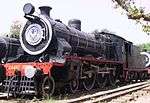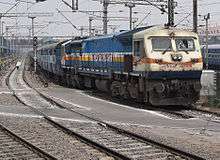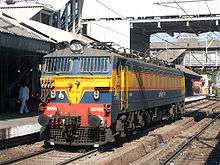Indian locomotive class WDM-2
|
A WDM-2 at Agra Cantt. Railway Station | |||||||||||||||||||||||||||||||||||||||||||||||
| |||||||||||||||||||||||||||||||||||||||||||||||
| |||||||||||||||||||||||||||||||||||||||||||||||
| |||||||||||||||||||||||||||||||||||||||||||||||
| |||||||||||||||||||||||||||||||||||||||||||||||
The class WDM-2 is Indian Railways' workhorse diesel locomotive. The first units were imported fully built from the American Locomotive Company (Alco) in 1962. Since 1964, it has been manufactured in India by the Diesel Locomotive Works (DLW), Varanasi. The model name stands for broad gauge (W), diesel (D), mixed traffic (M) engine. The WDM-2 is the most common diesel locomotive of Indian Railways.
The WDM-2A is a variant of the original WDM-2. These units have been retro-fitted with air brakes, in addition to the original vacuum brakes. The WDM-2B is a more recent locomotive, built with air brakes as original equipment. The WDM-2 locos have a maximum speed of 120 km/h (75 mph),[1] restricted to 100 km/h (62 mph) when run long hood forward - the gear ratio is 65:18.
History


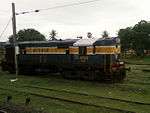
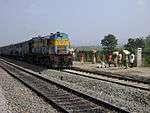
In the early 1960s Indian Railways began conversion of its mainline from steam to diesel locomotives. For this conversion General Motors Electro-Motive Division (EMD) and the American Locomotive Company (ALCO) were asked to submit designs for new diesel locomotives. Each company submitted prototypes. Indian Railways designated these prototypes the WDM-4 class and the WDM-2 class respectively. Technologically the General Motors WDM-4 was superior to ALCO's WDM-2, but Indian Railways required a transfer of technology agreement that would allow these locomotives to be manufactured in India. General Motors did not agree to the transfer of technology agreement so the ALCO prototype was selected for production. The first few prototype WDM-2s were imported. After Diesel Locomotive Works (DLW) completed construction of its factory in Varanasi, production of the locomotives began in India. The first 12 locos were built using kits imported from ALCO in the United States. After that DLW started manufacturing the WDM-2 locomotives from their own components. Since then over 2,800 locomotives have been manufactured and the WDM-2 has become the most popular locomotive in India.
However, even before the arrival of WDM-2 another type of diesel locomotive was imported from ALCO beginning in 1957. This locomotive was classified as WDM-1.
Later a number of modifications were made and a few subclasses were created. This includes WDM-2A, WDM-2B and WDM-3A (formerly WDM-2C). Now a few WDM-2 locos are being rebuilt by Diesel Loco Modernization Works (DLMW) Patiala, Punjab - These are fitted with Daulat Ram DBR's
The WDM-2 is the diesel workhorse of the Indian Railways, being very reliable and rugged.
Some of the sheds holding WDM 2 locomotives
- Abu Road
- Bardhaman
- Bokaro Steel City
- Ernakulam
- Erode
- Gonda
- Guntakal
- Guwahati
- Howrah
- Itarsi
- Jamalpur
- Jhansi
- Kalyan
- Katni
- Kazipet
- Krishnarajapuram
- Lucknow
- Malda Town
- Moula Ali
- Mughalsarai
- Golden Rock
- Pune, Diesel Loco Shed, Pune
- Raipur
- Ratlam
- Samastipur
- Shakurbasti
- Tughlakabad
- Vatva
- Vijayawada
- Visakhapatnam
Technical specifications[2]
| Manufacturers | Alco, DLW |
| Engine | Alco 251-B, 16 cylinder engine, 2,600 hp (1,900 kW) (2,430 hp or 1,810 kW site rating) with Alco 710/720/?? turbo supercharged engine. 1,000 rpm max, 400 rpm idle; 228 mm × 266 mm (8.98 in × 10.47 in) bore x stroke; compression ratio 12.5:1. Direct fuel injection, centrifugal pump cooling system (2,457 L/min or 540 imp gal/min or 649 US gal/min at 1,000 rpm), fan driven by eddy current clutch (86 hp or 64 kW at 1,000 rpm) |
| Governor | GE 17MG8 / Woodwards 8574-650 / Medha MEG 601 |
| Transmission | Electric, with BHEL TG 10931 AZ generator (1,000 rpm, 770 V, 4,520 amperes) |
| Traction motors | GE752 (original Alco models) (405 hp or 302 kW), BHEL 4906 BZ (AZ?) (435 hp or 324 kW) and (newer) 4907 AZ (with roller bearings) |
| Axle load | 18.8 t (18.5 long tons; 20.7 short tons) |
| total weight | 112.8 t (111.0 long tons; 124.3 short tons) |
| Bogies | Alco design cast frame trimount (Co-Co) bogies |
| Starting TE | 30.4 t (29.9 long tons; 33.5 short tons), at adhesion 27% |
| Length over buffer beams | 15,862 mm (52 ft 1⁄2 in) |
| Distance between bogies | 10,516 mm (34 ft 6 in) |
In Sri Lanka

Eight WDM-2 locomotives were purchased by Sri Lanka Railways, the state run railroad operator in Sri Lanka in 1996. They were the longest and most powerful locomotives owned by Sri Lanka Railways at that time. They were allocated the M8 Class.[3] However some modifications to the appearance were done by SLR.[4]
Fleet[5]
| Country | Railroad | Class | Quantity | Road Numbers | Notes |
|---|---|---|---|---|---|
| Sri Lanka | Sri Lanka Railways | M8 | 8 | 841 - 848 | All locomotives are operational. |
See also
- History of rail transport in India
- Indian Railways
- Locomotives of India
- Rail transport in India
- Sri Lanka Railways M8
References
Notes
Bibliography
- Hughes, Hugh (1996). Indian Locomotives: Part 4 – 1941–1990. Harrow, Middlesex: The Continental Railway Circle. ISBN 0-9521655-1-1.
External links
| Wikimedia Commons has media related to Indian locomotive class WDM2. |
